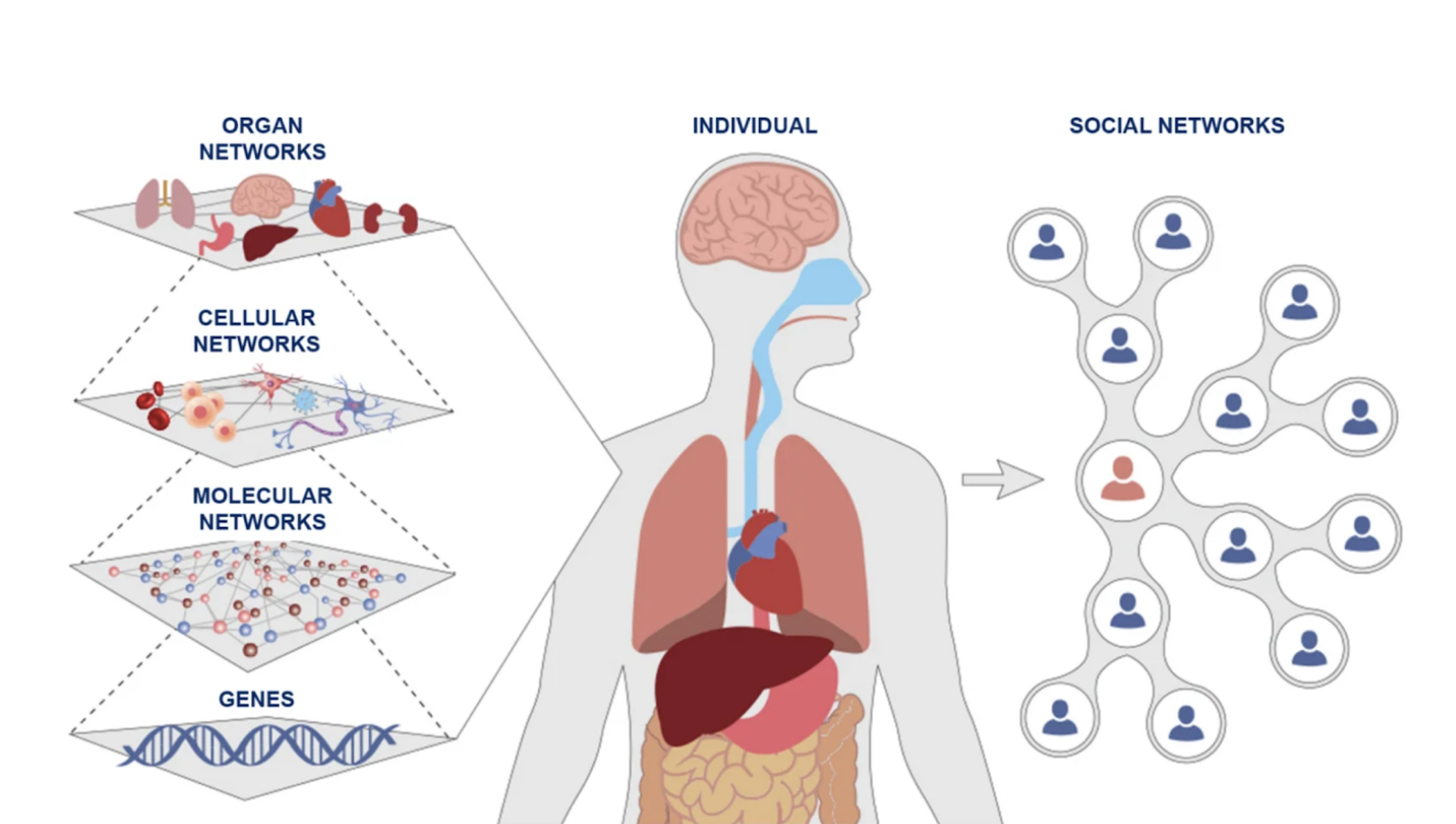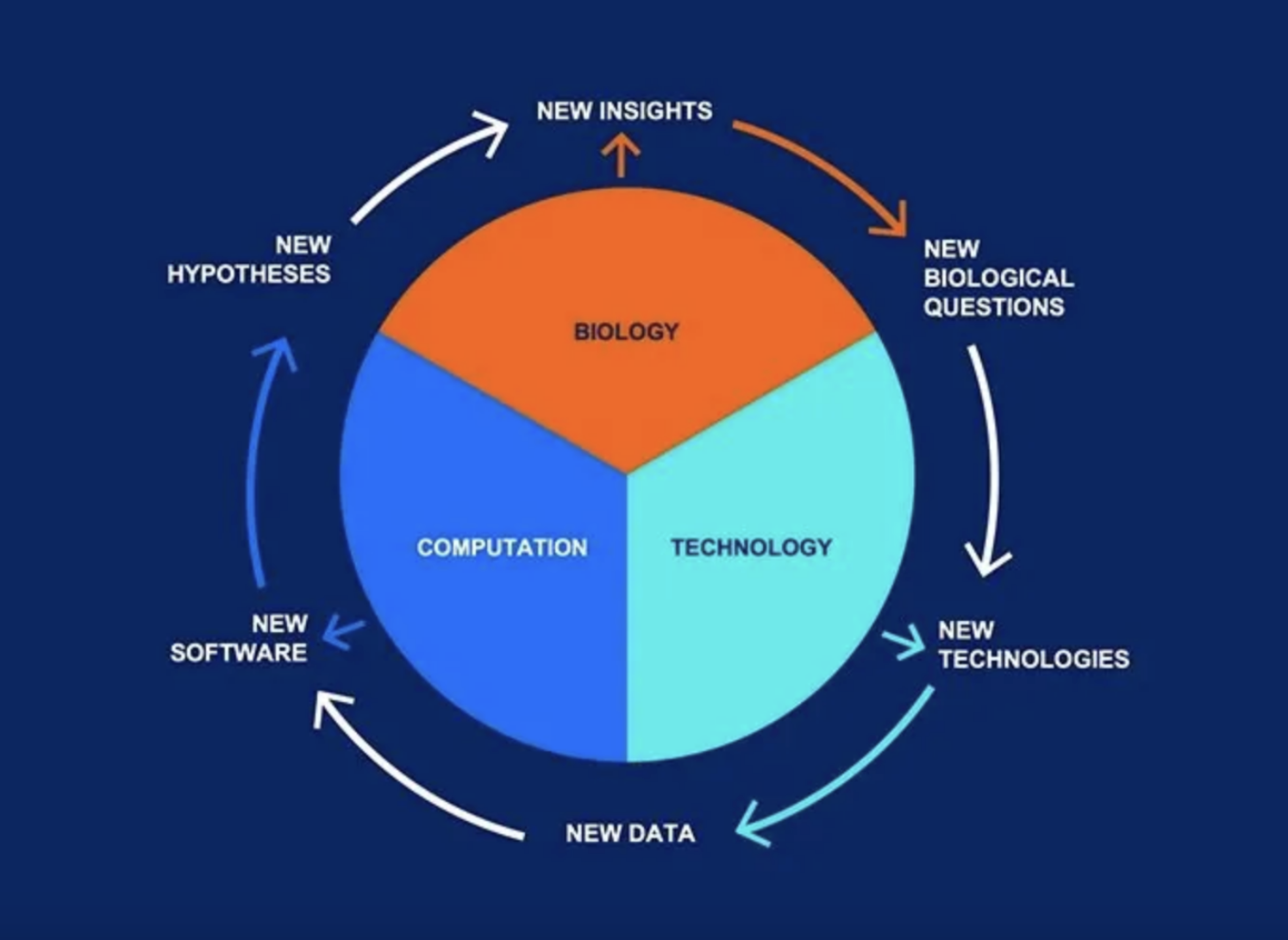
May 01, 2025
Life Sciences
Systems Biology Modeling Software for Researchers: The Hidden Value
Computational modeling has grown into a crucial resource for researchers who aim to understand how living systems function. According to Bioinformatics Advances, “Computational models are now approaching the complexity required to simulate full human systems — from single cells to entire organs — enabling in silico experiments for treatment prediction and disease modeling.” This milestone reveals much more than raw computational power. It highlights how specialized systems biology software helps scientists understand, forecast, and even influence intricate biological functions.
 Biological Networks Across Scales: Systems biology integrates networks from genes to organs and even social systems, highlighting how interconnected our biology truly is.
Source: Institute for Systems Biology
A study in PLOS One noted that systems biology connects theoretical data with lab results. By using computational models in their workflow, researchers can simulate hundreds or thousands of scenarios. Experimental data then refines these models creating more accurate predictions of actual biology.
Biological Networks Across Scales: Systems biology integrates networks from genes to organs and even social systems, highlighting how interconnected our biology truly is.
Source: Institute for Systems Biology
A study in PLOS One noted that systems biology connects theoretical data with lab results. By using computational models in their workflow, researchers can simulate hundreds or thousands of scenarios. Experimental data then refines these models creating more accurate predictions of actual biology.
 A cycle of biology, technology, and computation driving shared scientific advancement.
Source: Institute for Systems Biology
A cycle of biology, technology, and computation driving shared scientific advancement.
Source: Institute for Systems Biology
What is systems biology modeling?
Systems biology modeling demonstrates how components like genes, proteins, metabolites, and cells work together. Instead of focusing on single molecules or pathways, researchers try to grasp biological behavior by looking at the whole network. This integrative approach helps explain complex problems such as disease development, treatment resistance and how genes are regulated. Biological Networks Across Scales: Systems biology integrates networks from genes to organs and even social systems, highlighting how interconnected our biology truly is.
Source: Institute for Systems Biology
A study in PLOS One noted that systems biology connects theoretical data with lab results. By using computational models in their workflow, researchers can simulate hundreds or thousands of scenarios. Experimental data then refines these models creating more accurate predictions of actual biology.
Biological Networks Across Scales: Systems biology integrates networks from genes to organs and even social systems, highlighting how interconnected our biology truly is.
Source: Institute for Systems Biology
A study in PLOS One noted that systems biology connects theoretical data with lab results. By using computational models in their workflow, researchers can simulate hundreds or thousands of scenarios. Experimental data then refines these models creating more accurate predictions of actual biology.
Why does accurate modeling matter?
Faster Drug Discovery
Drug discovery often takes too long and costs too much. Research from PMC indicates computational systems biology tools can speed up early drug screening significantly. Software platforms integrating diverse datasets, genomics, proteomics and metabolomics help scientists predict side effects and refine compounds before major investment, shortening the path to clinical trials.Personalized Medicine
Precision medicine aims to tailor treatments based on a person's unique biology. A paper in Journal of Translational Medicine suggests advanced modeling helps researchers customize therapies. They can simulate how specific genetic variations respond to treatments. This reduces the guesswork in patient care potentially lessening side effects and improving results.Finding Hidden Connections
Living systems are complex. Feedback loops, overlapping enzymes, and parallel pathways make it hard to know what’s really going on. A PMC article explains how advanced algorithms can spot unexpected interactions, ones that might explain odd lab results or reveal surprising drug targets. These insights help steer future studies in more focused directions.How does software power these advances?
Data Integration
Effective systems biology needs large varied datasets, multi-omics data, clinical records and sensor outputs. Tools that merge and standardize this information simplify cross discipline research. According to DDW, consistent data formats decrease errors and simplify the comparison of different experimental conditions. For managing vast amounts of genomic and phenotypic data in the cloud, platforms such as Amazon Omics provide scalable storage and processing, useful for complex biology projects. A cycle of biology, technology, and computation driving shared scientific advancement.
Source: Institute for Systems Biology
A cycle of biology, technology, and computation driving shared scientific advancement.
Source: Institute for Systems Biology
Algorithm Sophistication
Different modeling types like deterministic, stochastic or agent based offer distinct views on biology. Sophisticated algorithms handle complex behaviors, time delays, and spatial factors letting simulations mimic reality better. A Nature study pointed to new machine learning methods for interpreting complex data. Automating parts of model building with software reduces guesswork, uncovering key insights faster.Collaboration and Reproducibility
Systems biology projects often unite diverse teams of biologists, computational scientists, clinicians perhaps working remotely. SaturnCloud’s review of computational biology platforms suggests good software needs version control collaborative tools and clear documentation. These features help track changes and ensure results can be reproduced and support peer review before publishing.What Features Should Researchers Look For?
User-Friendly Interfaces
An intuitive interface is important since coding skills vary. Visual tools with drag and drop options shorten the learning curve allowing researchers to run experiments, view results and tweak parameters without heavy coding.Integration with Experimental Data
Simulations alone have limited use. Good modeling software should easily connect with lab equipment, public databases and data management systems. This connection speeds up testing cycles and allows quick adjustments to experiments. With the rise of single-cell atlas technology in life sciences, efficient data integration is now more important than ever for understanding cellular heterogeneity at unprecedented depth.Scalability and Performance
Systems biology models can be dense networks needing significant computing power. Cloud based options provide necessary resources for large simulations helping researchers avoid slowdowns on local machines.Regulatory and Compliance Support
Translating discoveries to clinics involves regulations. Software with compliance features like secure data handling and audit trails helps research groups meet guidelines more easily.Are there specific challenges to keep in mind?
The same detail that makes models useful can also make them hard to read. Bioinformatics Advances points out that big simulations can produce way too much output. That’s where data visualization—heatmaps, interactive graphs and 3D views—becomes essential. Models also need to be checked against the real world. Translational Medicine research stresses the importance of cycling between prediction and experiment. Models don’t replace lab work; they help guide it. And then there’s the learning curve. Some platforms need high-end hardware or advanced training. PLOS One reminds us that teams have to weigh the upfront costs (licensing, training) against long-term productivity.Accelerating In Silico Experiments with Biosimulation Tool
A practical example of systems biology modeling involves a Kanda project. A biotech team required a custom biosimulation platform to minimize wet-lab experiments and speed up early drug discovery. The platform brought together genomic, proteomic, and other high-throughput data in a secure cloud environment. This enabled researchers to simulate various therapeutic pathways, predict results more accurately, and swiftly modify models as new data became available. Kanda focused on usability, designing an intuitive interface. This allowed wet-lab scientists and computational biologists to work together smoothly. Since future clinical trials were planned, the platform incorporated compliance features to adhere to regulatory standards. This case demonstrates how a suitable technology partner can simplify in silico research. It allows scientists to concentrate on finding key insights and advancing new therapies towards clinical application.What's Coming Next in Systems Biology Modeling
Machine learning is already shaping model development by filtering through giant datasets to find meaningful variables. That speeds up research and reduces trial-and-error. Some platforms are starting to take in real-time data from wearables and sensors, adjusting predictions on the fly. That kind of dynamic modeling could change how we think about personalized care. As systems biology grows, new partnerships form between researchers, developers and healthcare providers. Integrated setups encourage interaction between scientific knowledge and analytics suggesting lab findings might reach clinical use faster in the future.How to Select the Right Partner for Systems Biology Modeling
Choosing software is one step, finding the right technology partner is another. Researchers often need help customizing solutions, integrating systems and getting ongoing support. An experienced team can refine workflows making sure the platform fits the research goals instead of forcing adaptation. Kanda works with biotech, pharma and healthcare groups to create and adapt modeling platforms focusing on compatibility, ease of use and future growth, helping researchers focus on science rather than tech hurdles. Talk to an expert to see how your team can harness the full power of systems biology modeling.Conclusion
System biology modeling software is a catalyst for discovery. These tools can uncover previously unknown pathways, predict patient reactions, and accelerate drug discovery pipelines. They also provide unique challenges, such as data complexity and the need for ongoing validation. Nonetheless, the ability to mimic whole organ systems and fine-tune specific treatments is already transforming scientific research. Systems biology software's hidden value is its capacity to condense complex data sets to pertinent conclusions.Related Articles

Scaling Biotechnology Software Development: From Research Prototypes to Enterprise-Grade Solutions
Biotech never stops moving forward, but turning a lab breakthrough into a product ready for the market is anything but straightforward. A key piece of that transition, which is often missed, is the evolution of the software behind the science. The flexible, one-off tools used in early experiments, often a collection of ad-hoc scripts, shared…Learn More
The Future of Drug Development Runs on Omics Data Platforms
Traditional drug development is running into a serious efficiency problem. Getting a new medicine to market now takes more than ten years and costs well over $2 billion on average, according to a recent study. Even though scientific breakthroughs keep arriving, the expense of R&D keeps climbing faster than the number of new approvals, a…Learn More
Computational Neuroscience Simulations: Combining Science and Technology
The human brain is an astonishingly complex network of approximately 86 billion neurons forming trillions of synaptic connections, making it one of science's biggest puzzles. Understanding its intricate functions is a huge undertaking. Computational neuroscience simulations are now a central way to bring together advanced scientific research and the latest technology to approach this challenge.…Learn More
Applications of Computer Simulation Software in Medicine and Pharmaceuticals
Getting new treatments into the hands of patients is a scientific challenge, and a financial one too. According to a JAMA Network Open study, the average cost to develop a new drug in the U.S. was around $879 million between 2000 and 2018. The same study notes that other research places the R&D cost for…Learn More

